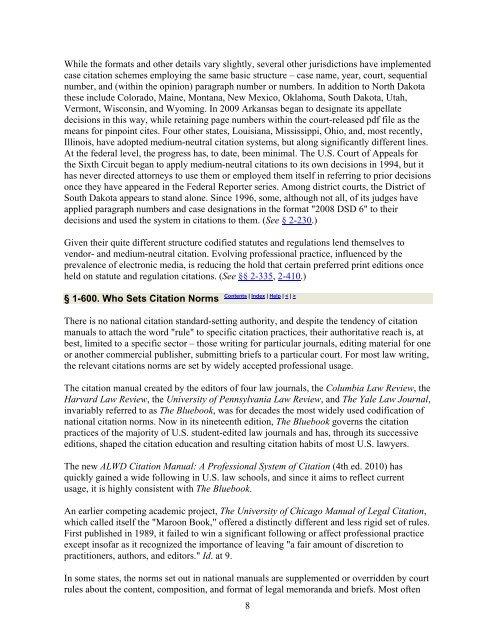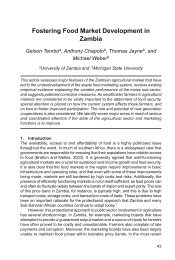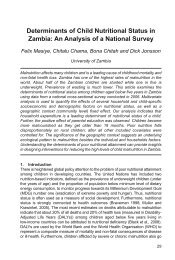Introduction to Basic Legal Citation - access-to-law home
Introduction to Basic Legal Citation - access-to-law home
Introduction to Basic Legal Citation - access-to-law home
You also want an ePaper? Increase the reach of your titles
YUMPU automatically turns print PDFs into web optimized ePapers that Google loves.
While the formats and other details vary slightly, several other jurisdictions have implemented<br />
case citation schemes employing the same basic structure – case name, year, court, sequential<br />
number, and (within the opinion) paragraph number or numbers. In addition <strong>to</strong> North Dakota<br />
these include Colorado, Maine, Montana, New Mexico, Oklahoma, South Dakota, Utah,<br />
Vermont, Wisconsin, and Wyoming. In 2009 Arkansas began <strong>to</strong> designate its appellate<br />
decisions in this way, while retaining page numbers within the court-released pdf file as the<br />
means for pinpoint cites. Four other states, Louisiana, Mississippi, Ohio, and, most recently,<br />
Illinois, have adopted medium-neutral citation systems, but along significantly different lines.<br />
At the federal level, the progress has, <strong>to</strong> date, been minimal. The U.S. Court of Appeals for<br />
the Sixth Circuit began <strong>to</strong> apply medium-neutral citations <strong>to</strong> its own decisions in 1994, but it<br />
has never directed at<strong>to</strong>rneys <strong>to</strong> use them or employed them itself in referring <strong>to</strong> prior decisions<br />
once they have appeared in the Federal Reporter series. Among district courts, the District of<br />
South Dakota appears <strong>to</strong> stand alone. Since 1996, some, although not all, of its judges have<br />
applied paragraph numbers and case designations in the format "2008 DSD 6" <strong>to</strong> their<br />
decisions and used the system in citations <strong>to</strong> them. (See § 2-230.)<br />
Given their quite different structure codified statutes and regulations lend themselves <strong>to</strong><br />
vendor- and medium-neutral citation. Evolving professional practice, influenced by the<br />
prevalence of electronic media, is reducing the hold that certain preferred print editions once<br />
held on statute and regulation citations. (See §§ 2-335, 2-410.)<br />
§ 1-600. Who Sets <strong>Citation</strong> Norms<br />
Contents | Index | Help | < | ><br />
There is no national citation standard-setting authority, and despite the tendency of citation<br />
manuals <strong>to</strong> attach the word "rule" <strong>to</strong> specific citation practices, their authoritative reach is, at<br />
best, limited <strong>to</strong> a specific sec<strong>to</strong>r – those writing for particular journals, editing material for one<br />
or another commercial publisher, submitting briefs <strong>to</strong> a particular court. For most <strong>law</strong> writing,<br />
the relevant citations norms are set by widely accepted professional usage.<br />
The citation manual created by the edi<strong>to</strong>rs of four <strong>law</strong> journals, the Columbia Law Review, the<br />
Harvard Law Review, the University of Pennsylvania Law Review, and The Yale Law Journal,<br />
invariably referred <strong>to</strong> as The Bluebook, was for decades the most widely used codification of<br />
national citation norms. Now in its nineteenth edition, The Bluebook governs the citation<br />
practices of the majority of U.S. student-edited <strong>law</strong> journals and has, through its successive<br />
editions, shaped the citation education and resulting citation habits of most U.S. <strong>law</strong>yers.<br />
The new ALWD <strong>Citation</strong> Manual: A Professional System of <strong>Citation</strong> (4th ed. 2010) has<br />
quickly gained a wide following in U.S. <strong>law</strong> schools, and since it aims <strong>to</strong> reflect current<br />
usage, it is highly consistent with The Bluebook.<br />
An earlier competing academic project, The University of Chicago Manual of <strong>Legal</strong> <strong>Citation</strong>,<br />
which called itself the "Maroon Book," offered a distinctly different and less rigid set of rules.<br />
First published in 1989, it failed <strong>to</strong> win a significant following or affect professional practice<br />
except insofar as it recognized the importance of leaving "a fair amount of discretion <strong>to</strong><br />
practitioners, authors, and edi<strong>to</strong>rs." Id. at 9.<br />
In some states, the norms set out in national manuals are supplemented or overridden by court<br />
rules about the content, composition, and format of legal memoranda and briefs. Most often<br />
8




